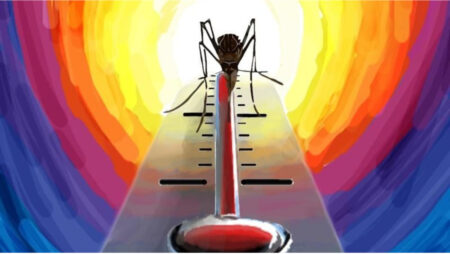In recent weeks, the national capital of India, Delhi, and its neighboring cities have found themselves grappling with a significant surge in cases of dengue and viral fever. This sudden outbreak, marked by a staggering rise in the number of dengue cases, has sent alarm bells ringing throughout the region. The Municipal Corporation of Delhi (MCD) has declared that the city is currently facing the highest number of dengue cases in the past six years, raising concerns about the effectiveness of public health measures and the need for a more proactive approach.
The genesis of this crisis can be traced back to the adverse climatic conditions experienced in the region, including bouts of heavy rains, persistent waterlogging, and flooding. These conditions have created a conducive environment for the proliferation of the Aedes mosquito, the vector responsible for transmitting the dengue virus. In this article, we will delve into the current situation, analyze the contributing factors, and shed light on the efforts being made to combat this public health emergency.
The Escalation of Dengue Cases :
The rapid escalation of dengue cases in Delhi is indeed a cause for concern. The numbers speak volumes: in May, the city reported 23 dengue cases, which then surged to 40 in June. However, the most alarming spike was witnessed in July when 121 new cases were reported. As if that wasn’t distressing enough, the month of August commenced with 105 new cases. In the past two weeks alone, Delhi has seen a steady and significant rise in dengue cases, prompting authorities and healthcare professionals to sit up and take notice.
Doctors on the Frontlines:
Amidst this escalating crisis, healthcare professionals are working tirelessly to diagnose and treat patients. Dr. Ajay Aggarwal, Director of Internal Medicine at Fortis Hospital in Noida, has shared valuable insights into the current medical scenario. He revealed that nearly half of the fever cases being reported are now being diagnosed as dengue. Patients are presenting with a range of symptoms, including high fever accompanied by chills, generalized malaise, weakness, joint pains, cough, vomiting, or loose stools. This multifaceted clinical presentation makes early diagnosis and treatment imperative.
Dr. Aggarwal further highlighted the emergence of H1N1 flu cases, with approximately 10-15 cases already detected at his hospital. The simultaneous occurrence of dengue and H1N1 flu cases adds complexity to the healthcare system’s response. Medical professionals must now simultaneously address multiple public health threats, necessitating robust surveillance, diagnostic capabilities, and patient management protocols.
Contributing Factors:
Several factors have converged to create the perfect storm for the dengue outbreak in Delhi and its neighboring areas. Firstly, the recent heavy rains and subsequent waterlogging have provided ideal breeding grounds for the Aedes mosquito, which thrives in stagnant water. Moreover, the inadequacies in the city’s drainage systems and waste management have exacerbated the problem, allowing water to collect and stagnate in various locations.
Secondly, urbanization and population density play a significant role in the rapid spread of the disease. As Delhi continues to expand, more people are living in close proximity to each other, providing a fertile ground for the virus to circulate.
Additionally, the public health infrastructure in the region faces its own set of challenges. The capacity for mosquito control measures, early detection, and efficient patient management is stretched thin, making it difficult to contain the outbreak effectively.
Response and Mitigation Strategies:
The government and local authorities have not remained idle in the face of this public health emergency. They have initiated a multi-pronged approach to combat the dengue outbreak.
International Collaboration and Research: In the face of the dengue outbreak, international collaboration and research also play a pivotal role. Delhi’s experience can be used as a case study for global health organizations and researchers to understand the dynamics of disease transmission in urban environments, especially in regions grappling with climate change-related challenges. Collaborative efforts with international experts can help develop more effective vaccines, treatments, and preventive strategies against dengue and other mosquito-borne diseases. This crisis highlights the interconnectedness of global health, emphasizing the importance of sharing knowledge and resources to combat emerging health threats.
The Role of Preparedness and Resilience: While Delhi is currently in the throes of the dengue outbreak, it’s essential to recognize the importance of long-term preparedness and resilience-building. Investments in public health infrastructure, disaster management, and climate adaptation measures can mitigate the impact of such outbreaks in the future. This outbreak serves as a reminder for policymakers to allocate resources and plan for a more resilient healthcare system that can respond effectively to both expected and unexpected health crises, safeguarding the well-being of the population and ensuring a healthier, more secure future for Delhi and other urban centers worldwide. In essence, the battle against dengue in Delhi is not just a current challenge; it’s a call to action for a more resilient and prepared future.
Mosquito Control: Intensive mosquito control measures are being undertaken to reduce the Aedes mosquito population. This includes fumigation, larvicidal treatments, and public awareness campaigns urging citizens to eliminate potential breeding sites around their homes.
Healthcare Infrastructure Strengthening: Hospitals and healthcare facilities are working tirelessly to ensure early diagnosis and treatment of dengue cases. Hospitals are also gearing up to handle additional cases of H1N1 flu.
Public Awareness: Public awareness campaigns are being intensified to educate the populace on preventive measures. Citizens are being encouraged to use mosquito nets, wear protective clothing, and use mosquito repellents.
Efforts for Rainwater Management: Authorities are addressing the issue of waterlogging and flooding with improved drainage systems and waste management strategies.
Collaboration with NGOs: Collaborative efforts with non-governmental organizations and community engagement are being encouraged to reach the most vulnerable populations effectively.
Conclusion:
The dengue outbreak in Delhi and its adjoining areas is a stark reminder of the intricate challenges faced by urban centers in tackling public health emergencies. It underscores the need for a comprehensive and proactive approach to mosquito-borne diseases, which includes not only immediate measures like mosquito control and healthcare infrastructure enhancement but also long-term strategies addressing urban planning, sanitation, and environmental sustainability.
The collaborative efforts of government agencies, healthcare professionals, and the public are vital in overcoming this crisis. Early diagnosis, effective treatment, and public awareness will be instrumental in curbing the dengue outbreak’s impact. Additionally, lessons learned from this outbreak should serve as a wake-up call for policymakers to invest in robust public health infrastructure, sustainable urban planning, and climate-resilient cities that can better withstand and respond to such health crises in the future.
In unity and with concerted efforts, Delhi and its residents can combat this outbreak and pave the way for a healthier and more resilient city.













